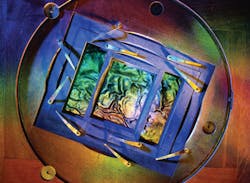Case in point: the John Deere facility in Bruchsal, Germany. The facility has an automated storage and retrieval system (ASRS) that needed an upgrade. In 2008, drives vendor SEW Eurodrive provided that upgrade, and saved the facility energy in the process.
The key was regeneration. An axis is motoring when power is flowing from the drive to the motor. Conversely, an axis is regenerating when power is flowing from the motor back into the drive. When an axis is regenerating, the power flowing into the drive needs to go somewhere. A common method for dealing with this power is to dissipate the energy with a resistor, often referred to as a braking resistor, where it is lost as heat.
But not in this case. SEW installed one of its inverters on each axis, along with a drive-based controller incorporated into one of the two inverters. This controller now controls all of the motion of the system. When given a command to retrieve (lower) a pallet, it calculates the travel time required for each axis. With that, and knowing that the Y-axis will regenerate the most energy when it reaches constant speed in the downward direction, it decides the optimal point to begin movement of the X-axis. This ensures that the maximum amount of energy retrieved from lowering is used to drive the travel drive. The same method is used during the hoisting operation. In each case, the overall cycle time is not reduced; rather, shifting the timing of the movement of each axis within the cycle yields optimal sharing of energy.
“This system was a very economical decision,” says Rich Mintz, national product manager at SEW Eurodrive, Lyman, S.C. “The components required were needed anyway: two gearmotors, two drives, a braking resistor and a motion controller. All we added were two cables to connect the DC buses. But, we were also able to eliminate a braking resistor. A conventional system would have had a braking resistor for each drive, whereas this system has only one.”
And energy consumption for the application? “Reduced by 25 percent.”
SEW installed a similar system at an automotive facility in Germany but with the addition of a regenerative power supply. The regenerative unit, which takes stored energy released from the system and puts it back onto the main incoming supply for use elsewhere in the facility, is connected to the DC bus in place of the braking resistor. “This system gave the customer an additional 15 percent reduction for a total of 40 percent less energy consumed from the utility,” says Mintz. “This system did require some additional hardware in the form of the regenerative unit, but the amortization was still less than two years.”
Meaty machine savings
CP Packaging LLC, of Appleton, Wis., is reaping the benefits of regenerative power as well. They did it with their new VisionPak six-axis horizontal form, fill and seal machine for prepackaged meat and deli products. It uses pre-printed filmstock that is unwound and fed into the machine, where it goes through a heat-forming lift-and-die process to create the container shape. The formed film advances to the center of the machine, where the meat product is added, and then it’s indexed to the end, where another roll of film is used to finish the package with a heating, vacuum, sealing and trimming process.
To achieve the desired control of the rollstock, forming and sealing process, CP utilized a half-dozen Rexroth IndraDrive Mi integrated servo motor/drive units supplied by Bosch Rexroth Corp., Hoffman Estates, Ill. They worked well, and the machine is living up to expectations, both mechanically and commercially. Up to this point, it’s a typical performance-based success story, but there’s more.
“The fact that it is an integrated motor/drive does not add any energy savings,” says Ray Buchko Jr., vice president of operations at CP Packaging. “However, since the axes share a common DC bus, we can share energy between axes. In our application, we have axes that are regenerating while others are motoring; and for the regenerating axes, instead of burning that energy off as heat through a bleeder resistor, the motoring axes use this energy—therefore, the net power consumption from the three-phase line is reduced.”
Buchko estimates a 15 percent to 20 percent power savings. Plus, since the drives are integrated into the motor and out of the enclosure, the need for an air conditioner is eliminated.
Subscribe to Automation World's RSS Feeds for Feature Articles
About the Author
Greg Farnum
Contributing Editor

Leaders relevant to this article:
